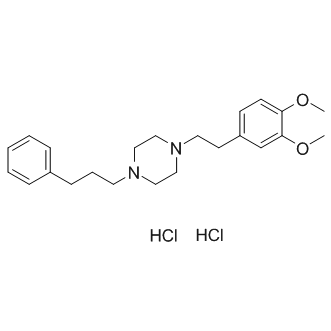| Cas No.: | 165377-44-6 |
| Chemical Name: | Cutamesine HCl |
| Synonyms: | SA4503; SA 4503; SA-4503; AGY94806; AGY-94806; AGY 94806; Cutamesine HCl; Cutamesine hydrochloride |
| SMILES: | COC1=C(C=C(C=C1)CCN2CCN(CC2)CCCC3=CC=CC=C3)OC.Cl.Cl |
| Formula: | C23H34Cl2N2O2 |
| M.Wt: | 441.437 |
| Purity: | >98% |
| Sotrage: | 2 years -20°C Powder, 2 weeks 4°C in DMSO, 6 months -80°C in DMSO |
| Description: | Cutamesine dihydrochloride (SA4503 dihydrochloride) is a potent Sigma 1 receptor agonist with an IC50 of 17.4 nM in guinea pig brain membranes. |
| Target: | IC50: 17.4 nM (σ1receptor, guinea pig brain membranes)[1] |
| In Vivo: | Cutamesine extends the survival time in the SOD1G93A mice[2]. |
| In Vitro: | The sigma receptor might be involved in several diseases in the central nervous system. Cutamesine, a potent σ1receptor agonist, has 103-fold higher affinity for σ1 (IC50=17.4 nM) than σ2 (IC50=1,784 nM) sites in guinea pig brain membranes. Cutamesine is 14-fold selective for σ1 (Ki=4.6 nM) over σ2 (Ki=63.1 nM) sites in guinea pig brain homogenates[1]. Cutamesine protects motor neuron NSC34 cells against superoxide dismutase 1 and serum free neurotoxicity. It upregulates the phosphorylation levels of Akt and extracellular signal-regulated kinase (ERK) 1/2[2]. Cutamesine reduces the activation of the MAPK/ERK pathway and down-regulated the ionotropic glutamate receptor, GluR1[3]. |
| Cell Assay: | The NSC34 cells are seeded at a density of 7000 cells per well into 96-well plates with D-MEM and transfected using Lipofectamine 2000 mixed with 2 μg /mL of plasmid vector in D-MEM for 6 h. After 6 h, the cell-culture medium is replaced with fresh D-MEM and culture and allowed to proceed for a further 42 h. The cells are then transferred to serum-free D-MEM and immediately treated with Cutamesine at a final concentration of 1, 3, or 10 nM[2]. |
| Animal Administration: | Mice: Transgenic female mice overexpressing mutated human SOD1G93A are used in the study. Cutamesine is dissolved in saline and subcutaneously administered at a dose of 1 mg/kg once daily to 5-week-old SOD1G93A mice to the time of death. In a control group, vehicle (saline) is subcutaneously administered at 10 ml/kg[2]. |
| References: | [1]. Lever JR, et al. Sigma1 and sigma2 receptor binding affinity and selectivity of SA4503 and fluoroethyl SA4503. Synapse. 2006 May;59(6):350-8. [2]. Tuerxun T, et al. SA4503, a sigma-1 receptor agonist, prevents cultured cortical neurons from oxidative stress-induced cell death via suppression of MAPK pathway activation and glutamate receptor expression. Neurosci Lett. 2010 Jan 29;469(3):303-8. |

 DC Chemicals' products qualify for U.S. tariff exemptions. We guarantee no price increases due to customs duties and maintain stable supply, continuing to deliver reliable research solutions to our American clients.
DC Chemicals' products qualify for U.S. tariff exemptions. We guarantee no price increases due to customs duties and maintain stable supply, continuing to deliver reliable research solutions to our American clients.





















